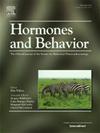阿波吗啡引起的雌性大鼠有节律性交配行为的破坏可以通过D2受体拮抗剂eticlopride而不是D1受体拮抗剂SCH 23390来减弱
IF 2.5
3区 医学
Q2 BEHAVIORAL SCIENCES
引用次数: 0
摘要
多巴胺与雌性大鼠的性动机和性唤起有关。本研究探讨了多巴胺受体1型(D1)和2型(D2)激动剂系统性阿波啡对无接触伴侣偏好和有节奏的交配行为的影响。去卵巢、激素启动、有性经验的雌性大鼠在伴侣偏好测试前10分钟接受80 μg/kg阿波啡或对照物,随后进行有节奏的交配测试(实验1)。伴侣偏好没有因治疗而不同。然而,与接受载体的大鼠相比,阿帕吗啡治疗的大鼠表现出更长的接触-返回潜伏期,更长的接触-返回潜伏期和射精潜伏期,更大的可能性在上马和射精后的戒断,更长的间隔时间,更少的与雄性的接触时间,以及更少的感知行为。为了验证阿波啡对有节律性交配行为的影响是否主要由D1或D2受体介导,在大鼠接受80 μg/kg阿波啡之前,先用25 μg/kg D2拮抗剂埃替氯pride或25 μg/kg D1拮抗剂SCH 23390预处理10分钟。然后测试大鼠的伴侣偏好和交配节奏,如实验1所示。依替氯pride预处理对阿帕吗啡的减毒作用;与生理盐水→阿扑啡处理大鼠相比,依替氯pride→阿扑啡处理大鼠表现出更短的接触-返回潜伏期、坐骑后退出的百分比、更短的间隔时间、更短的与雄性接触的时间和更多的感知行为。SCH 23390预处理不影响阿波啡的作用。阿波啡仅在有可能交配时才会影响性动机,这表明多巴胺的操纵影响了支持性刺激行为反应的生理机能。本文章由计算机程序翻译,如有差异,请以英文原文为准。
Apomorphine-induced disruption of paced mating behavior in female rats is attenuated by eticlopride, a D2 receptor antagonist, but not SCH 23390, a D1 receptor antagonist
Dopamine is linked to sexual motivation and genital arousal in female rats. The present study investigated the effects of systemic apomorphine, a dopamine receptor-type 1 (D1) and -type 2 (D2) agonist, on no contact partner preference and paced mating behavior. Ovariectomized, hormone-primed, sexually experienced female rats received 80 μg/kg apomorphine or vehicle 10 min before a partner preference test followed immediately by a paced mating test (Experiment 1). Partner preference did not differ by treatment. However, apomorphine-treated rats exhibited significantly longer contact-return latencies to mounts, intromissions, and ejaculations, greater likelihood of withdrawal after mounts and intromissions, longer intervals between intromissions, reduced time with male, and fewer proceptive behaviors compared to rats receiving vehicle. To test whether effects of apomorphine on paced mating behavior were mediated primarily by D1 or D2 receptors, rats were pretreated with 25 μg/kg eticlopride, a D2 antagonist, or 25 μg/kg SCH 23390, a D1 antagonist, 10 min before receiving 80 μg/kg apomorphine. Rats were then tested for partner preference and paced mating as in Experiment 1. Eticlopride pretreatment attenuated effects of apomorphine; eticlopride → apomorphine-treated rats displayed significantly shorter contact-return latencies to intromission, reduced percentage of exit after mounts, shorter intervals between intromissions, decreased time with male, and more proceptive behaviors relative to saline → apomorphine-treated rats. Effects of apomorphine were not altered by SCH 23390 pretreatment. Apomorphine only affects sexual motivation when mating is possible, indicating that dopamine manipulation influences the physiology that supports behavioral response to sexual stimulation.
求助全文
通过发布文献求助,成功后即可免费获取论文全文。
去求助
来源期刊

Hormones and Behavior
医学-行为科学
CiteScore
6.70
自引率
8.60%
发文量
139
审稿时长
91 days
期刊介绍:
Hormones and Behavior publishes original research articles, reviews and special issues concerning hormone-brain-behavior relationships, broadly defined. The journal''s scope ranges from laboratory and field studies concerning neuroendocrine as well as endocrine mechanisms controlling the development or adult expression of behavior to studies concerning the environmental control and evolutionary significance of hormone-behavior relationships. The journal welcomes studies conducted on species ranging from invertebrates to mammals, including humans.
 求助内容:
求助内容: 应助结果提醒方式:
应助结果提醒方式:


